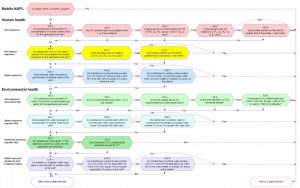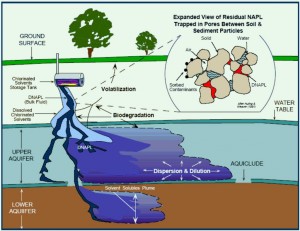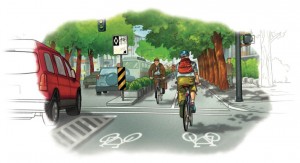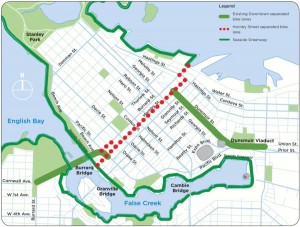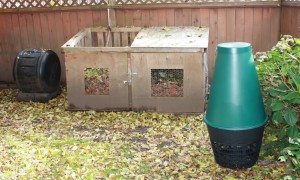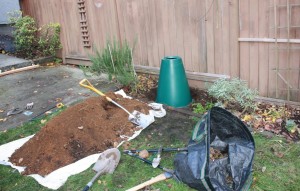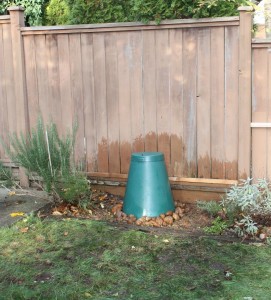Wow, what a night. There were a lot of people at the Justice Institute last night, and lots of lively discussion about the United Boulevard Extension. Now, I might be biased, but the overwhelming message from people I talked to was that this project is a non-starter.
The TransLink staff might have been a little over whelmed by the turnout, the room was often packed beyond comfort, and it was hard to spend a lot of time at each display poster, as there were so many people about. The displays were a little short on detail, and a lot short on rationale. But the plans were pretty clear.
The questionnaire offered to us for comments began with a strange question, and one that was hard to answer: “Are all the problems defined”?
Hmmm… there are vague references to moving goods, greenhouse gasses, and bad intersections, even a suggestion that the Bailey Bridge was dangerous for pedestrians and cyclists, many references to “Challenges”, but it was hard to determine how any “problem” was being solved.
Truck Traffic? The trucks backed up at the Bailey bridge pale in comparison to the trucks backed up at Front Street or Stewardson Way. This may be a choke point, but hardly the only one.
Truck Pollution? Too many trucks belching diesel on the Brunette will somehow be cured by adding more room for trucks?
Cycling access? The Bailey bridge is pretty bike-friendly, as it is one lane (no on-coming traffic) and everyone pretty much crosses it at cycling pace. More importantly, the bike trail behind the Braid Station connects seamlessly, and the stretch on United Boulevard east of there is great for bikes: but ironically built too narrow for 4 lanes of traffic and bike lanes: no plan here to widen United. This project may hurt cycling access.
Seems to me, the only real “problem” being addressed here is the $65 Million dollars of Federal money that has to be committed by Christmas, before it turns into a pumpkin.
That seems like a lousy reason to spend another $100 Million and to invite more trucks and cars into our City. At least until there is a plan, with committed funding sources, to manage the traffic once it enters out City.
The good news is that I heard very encouraging things from the Mayor and Councillors who attended. This is not a done deal, and they all assured me no decision would be made unless it served the people of New Westminster. At this point, I am taking them at their word.
I was simultaneously encouraged and concerned by the Mayor’s words on the CBC this morning, which I transcribe here, in their entirety, for the record:
Why this project?
“In the lower mainland, there is properly not another pug for the transportation system or the trucking than there is on the Translink portion of the Gateway Project. That goes all the way from our Queensborough Bridge right through the City and ending up at the Braid Street Connection which goes onto Highway #1. And so, with this back-up, they have been trying to fix this for years and years since I’ve been here and we are in the process now of looking to see how do we do this so it mitigates the problems for the travel industry, but as importantly, how do we take care of the Citizens of New Westminster with as least an intrusion as possible.”
On removing houses:
“Well, first of all, before the decision is made that we will lose anything, we will make the decision. That has not been made. We made it perfectly clear to TransLink that we ware going to go to the public and let them see what the four options are, before council makes a decision of what their choice is. I can tell you, probably, there is no-one who wants the disruption you are talking about, and we are not going to support some disruption. Let’s see the people tonight, there will be lots of them coming out, I’m sure.”
Quote from Sapperton McBride Residents Association President (paraphrased): Residents were surprised, didn’t like “freeway interchange” design, wondered why were these options never raised in the past?
“Well, because they just came up (chuckle). So it is very simple. It was just brought to our attention, and as soon as it was brought to our attention, we said “Just wait a minute, we’ll take this back to the public, you will hear from the people of New Westminster, you’ll hear from this council, and then we will sit down and we will see what had to be done, if we want to go ahead with this. Because, if there is no benefit to the City of New Westminster, there is not going to be much support to go forward at all. We are trying to help the region, but the region has to make sure we are kept whole, that this City isn’t affected by just being a transition place for cars to drive through and hurt our neighborhoods. I can guarantee you that.”
On Federal Funding:
“The deadline for the matching funds, which is approximately $60-65 Million, is at the end of December, I think December 31st. Now let’ face it, it is good to have some additional funding that comes come through, but we have to be very careful that what we are going to do is not create more problems than what this amount of money will give. Now, since we have been in this situation for this piece of property or this roadway, it has gone three times the value that it was ten years ago, since I have been here. This comes right back to the funding. The funding for transportation has to be changed. It is no longer so simple that you give something that is so important to everybody in the region no method of funding. And that’s what this is. Now we are trying to match the $65 Million, it is still going to be short, we are going to have to come up with another 25 or 30 Million, if there is a particular choice that is made, because the choice that looks best for the City is what is called the “T”choice, in the shape of a “T”, and that T is I Think $170 Million dollars now, and the other choices may save them a bit of money, $120 Million or $150 Million dollars, but let’s face it, this is forever in this neighborhood, in this community, and we are going to go for the one, if we go forward, that is going to make sense for us, as well as the region.”
Where is the Grand plan? How does this fit a bigger plan?
“I have no idea, I have asked many times why TransLink has this piece of the Gateway. Why; no-one has ever been able to explain to me. But I can tell you this, we are also, with the uh, Translink organization, we have given them things that we need. We have given them the Front Street, which is our main downtown area, which is part of this, has to come forward, we have to have and agreement about how that will be fixed, if it is un… if it is encapsulation , if it is tunneling, but that has to be dealt at the same time as this. It is part of the broad corridor that is there. The Brewery study has to be done, that ii s where the old Labatt’s is, that corner has to be looked at, if you look at it: it is part of it. Then when you come down to McBride, You’ll see that’s where the trucks all stop because there is light down there that comes up from the bottom and it needs to have a tunnel. Now we’ve talked about that. We have talked about the bridge ramps that are coming. All of these things are part of a bigger picture you are asking about, and that’s what we are negotiating right now with the TransLink people”.
What about tonight’s meeting?
“I think the people will come forward, The question Mr. Pinkerton asked “how come we didn’t know before” will be answered pretty quickly. They’ll show all the slides, of what they want to do, and they will have some of us there saying “wait a minute, take a look at this, this is what we have been talking about for the past 10 years, and you people give us your opinions”. Now, I think we will end up, at the end of the day, people are going to say if it has to come, this is the particular one that looks like the one that we may be able to live with. Now give it back to the Council, let us negotiate with the Translink people. The council has been here long enough that, we don’t sit in a room with them and our staff and let anyone run over us. We’ll be alright.”
That last line was encouraging, as it reminded me of the neon sign/installation art by Martin Creed, visible over the DTES from the Skytrain when pulling out of the Stadium station. In big, white, friendly letters, the sign simply says: “everything is going to be alright”.
But I was also concerned that in the ten years he “has been here”, none of the traffic problems have been solved between the Queensborough and Braid. Yes, there are multiple jurisdictions, multiple pressures, no money, etc. But I think after 10 years of no action, our local leaders should stop looking for others to make their plans for them, and step up with some policy. After 10 years, we should have stronger statements from our local leaders than “let’s see what they offer, and if there is outcry from the public, then we will react”.
Instead of winging about our traffic fate, New Westminster should say what we will and will not accept for Front Street, for Columbia, for Braid, for Royal and for Eighth Ave. That way, when TransLink or MoT show up with hastily-assembled plan to patch one area, the answer from the City is is easy: does this meet the City’s policy objectives, our Master Plan? This year, the City is updating it’s Master Transportation Plan. Let’s include the higher-level policy statements about how we want to move cars, goods, and people thorugh our City. Let’s stop waiting for others to identify and scab over our traffic woes: let’s make policy now and get ahead of this issue. Beats waiting ten more years. The time is now.
